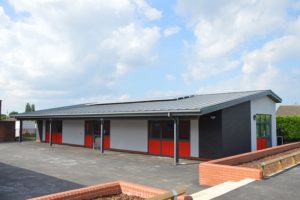 After considering traditional standing seam metal roof options, the design team for a new school building in Norwich specified Catnic’s steel SSR2 Standing Seam Roofing and Cladding system. The system proved fast to install and has created a contemporary, low maintenance roof that offers high thermal performance, impressing the design and construction team.
After considering traditional standing seam metal roof options, the design team for a new school building in Norwich specified Catnic’s steel SSR2 Standing Seam Roofing and Cladding system. The system proved fast to install and has created a contemporary, low maintenance roof that offers high thermal performance, impressing the design and construction team.
Designed by Norwich-based NPS Group to expand Sparhawk Infant and Nursery School’s capacity, the new self-contained school building covers a footprint of 204sqm. It houses two classrooms, a lobby area, unisex and disabled toilets and a plant room.
The single storey, timber-framed building features a smooth, light grey insulation render with contrasting slate grey, timber grain effect cladding panels. Grey aluminium powder coated thermally broken windows and doors also incorporate coloured insulated panels in a striking a letterbox red, linking into the school identity colour palette. The roof completes the building and features Catnic’s SSR2 in a mid grey colour called Merlin (BS18B25).
The roof design had an important role to play in achieving planning permission for the new school building as the contract administrator and lead designer, NPS Group’s Associate Architectural Technologist Mark Terrington, explains: “The building sits in close proximity to a neighbouring residential area. The objective from a design and planning perspective was to create a sympathetic, low-level roofline that would work aesthetically and not overpower adjacent properties. Catnic’s SSR2 can be specified for pitched roofs as low as 5°, so we introduced a 10° pitch and ridge. This enabled us to keep the roof level lower, in line with planning requirements. Also, internally, the roofline follows the pitch, which creates a real sense of space in the classrooms.”
The roof specification comprised an engineered timber JJI-joist roof construction, acoustic ceiling supported off MF grid with 200mm plenum and 50mm quilt insulation, a vapour control layer, 9mm OBS lining sheet, 300mm cellulose fibre insulation pumped in JJI roof void, 18mm OSB sheathing, breather membrane with SSR2 fixed directly to OSB sheathing.
Mark Terrington continues: “This is the first time we have specified the SSR2 system and are impressed with the results. It’s definitely a product we will look to use on projects in the future. Originally, we were looking at traditional aluminium coated standing seam roof options. What interested us about the Catnic SSR2 system, apart from the aesthetics, was the fact that it is fixed straight on to the OSB deck, making it quick and efficient to install. In addition, Catnic prepared all the necessary thermal dew-point calculations and the school is pleased with the results from an acoustics perspective too.”
A cost-effective alternative to traditional copper and zinc standing seam roof systems, the SSR2 system is manufactured to meet all relevant legislation, including load bearing for wind speed in accordance with EN 1991-4 and weather tightness in accordance with BS 5534 Parts 1 and 2. Furthermore, helping to meet requirements for sustainable building solutions – SSR2 is BRE Green Guide Rated ‘A’ and at end of life – the panels are 100% recyclable.
The principal contractor, Cocksedge Building Contractor Ltd secured this project on the Norfolk Framework and worked closely with the SSR2 roofing installer AM Roofing Services. Contracts Manager Steve Revell said: “The company provided an efficient install, which included SSR2 metal seam roof, fascia, soffit and rainwater gathering accessories.”
Andrew Morris, of AM Roofing Services, concludes: “We installed 295 sqm of the SSR2 Standing Seam Roofing and Cladding system in just five days. For projects like the Sparhawk roof, the install is straightforward. We’ve completed over 100 SSR2 projects now and in our experience the skill comes with detail, as with most products.
“It’s a popular, modern system that offers very little maintenance, great aesthetics and a 40-year guarantee plus it’s environmentally friendly – I believe it’s the future of roofing.
“The difference between SSR2 and more traditional roofing methods is that the SSR2 is fitted to an 18mm OSB or ply, as opposed to batons. This makes it so much easier to work with. We are able walk on a solid surface and it’s much quicker to fit one full size sheet, which really saves time.”
Solar panels were also installed under the principal contractor’s remit, specified to complement onsite energy requirements. The SSR2 system accommodates this requirement easily with the use of a simple fixing bracket that clamps on to the standing seam upstand. This allows the PV panels to be installed without needing to put holes through the roof and keeps the installation process simple.

